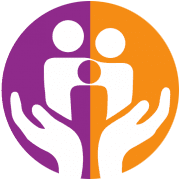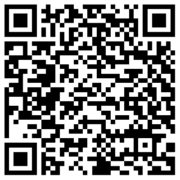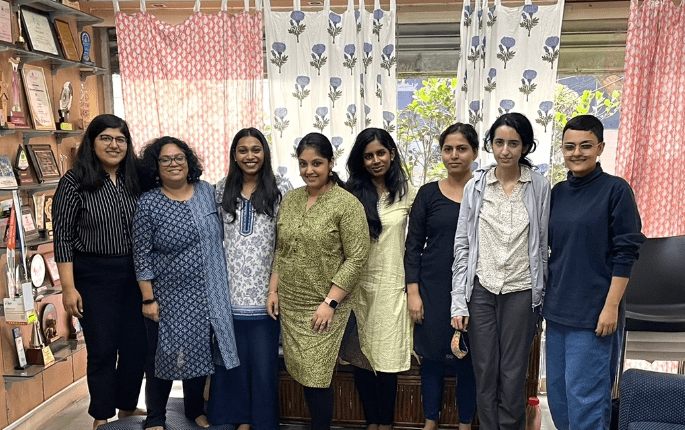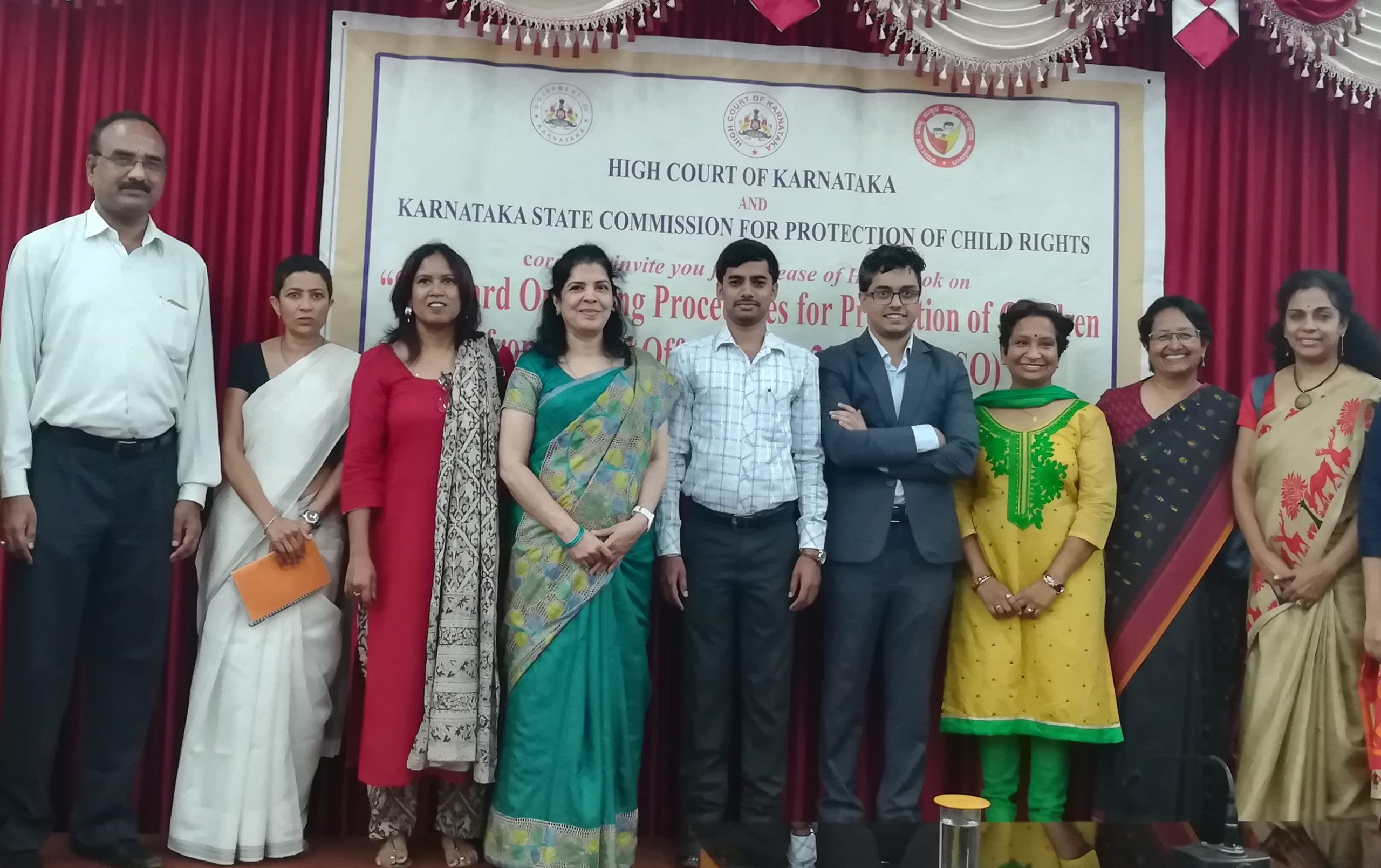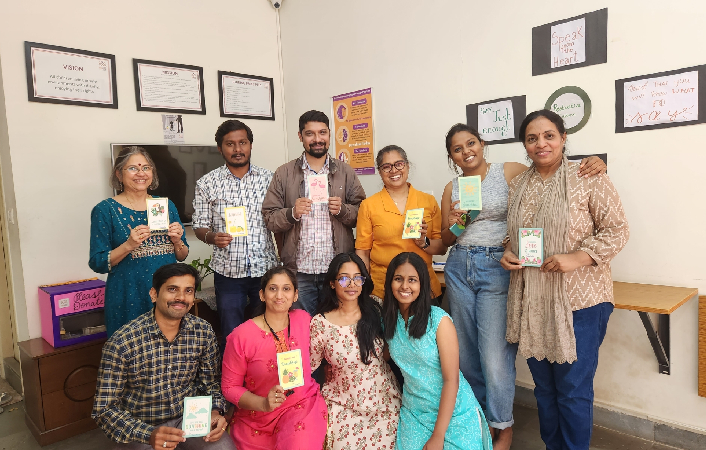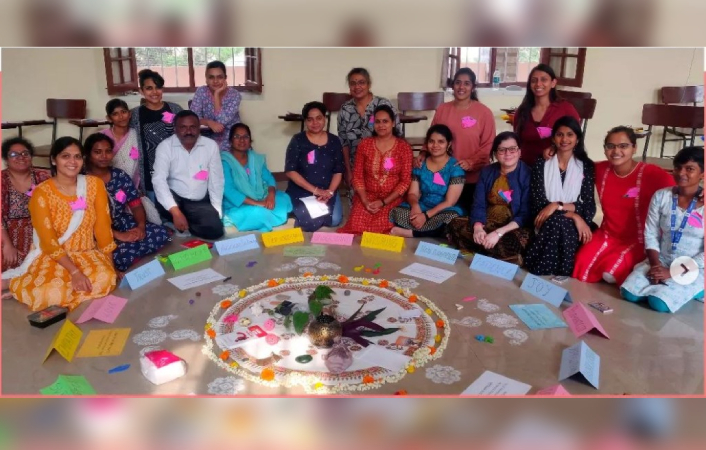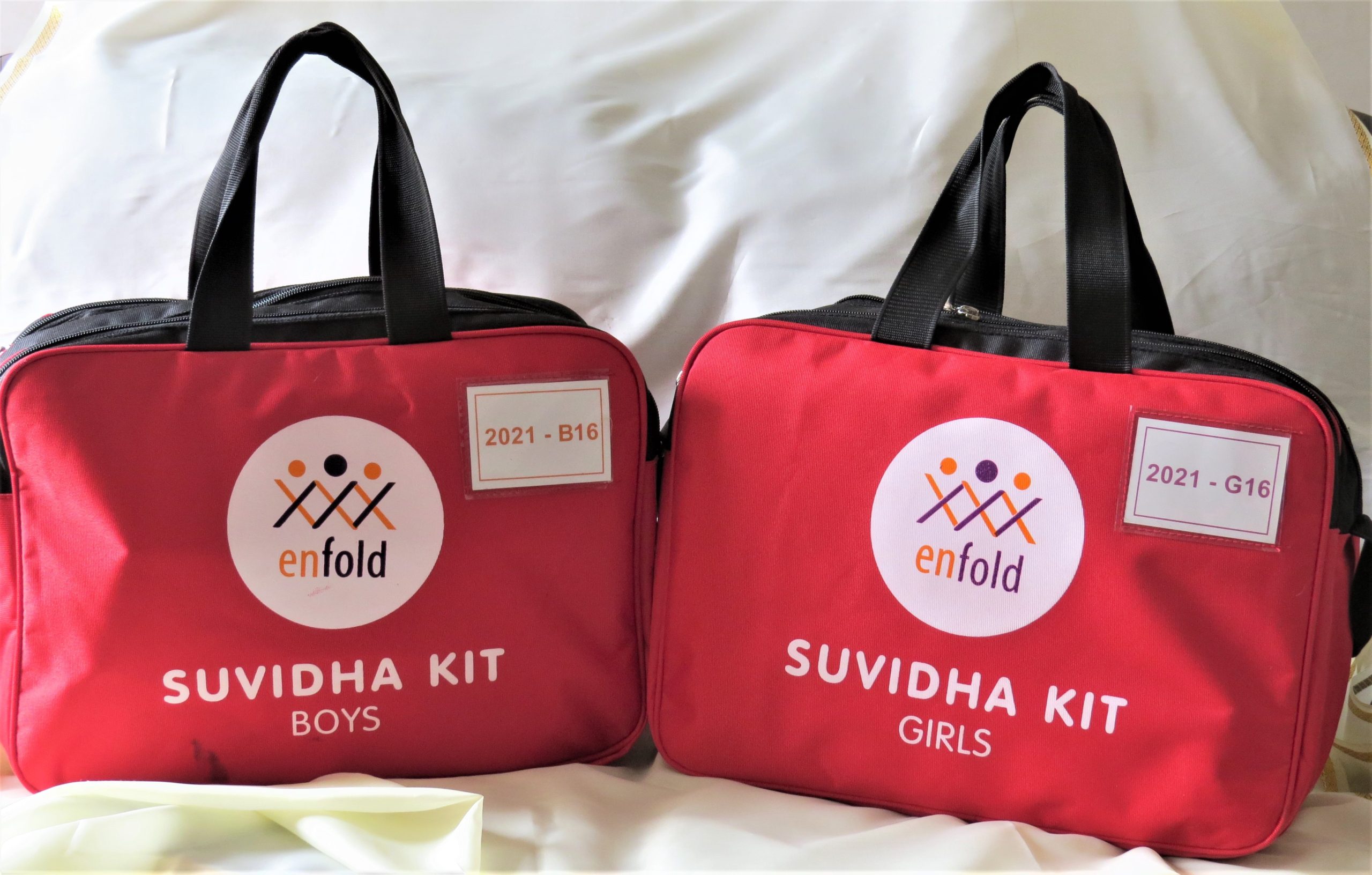Introduction
All children and adolescents, with and without disabilities, have the right to age and developmentally appropriately comprehensive sexuality education (CSE) that is value and rights based and culturally relevant. As a part of sexuality education, children and adolescents have the right to learn about and exercise the personal safety rules. Such educationIt enables children in developing an understanding of and respect for their body and its functions. It would helps them understand and follow social sexual norms for clothing, touching and talking, identify unsafe behaviour and confidently report it to their safe adults without fear of being shamed, blamed or stigmatized. People would hold the person who behaves in an unsafe manner person responsible and accountable and support the victim to heal.
Discussion on sexuality would help adolescents navigate puberty with dignity, experience their sexuality without guilt or shame and express it in socially responsible and appropriate ways. Their right to sexual and reproductive health education and related services would be respected and enabled.
About Bal Suraksha App
Bal Suraksha App helps you prevent and manage child sexual abuse. Responsibilities of parents, schools, doctors, nurses, police, lawyers and media towards the child and how to deal with the perpetrator are elaborated. Helping children learn Personal Safety Rules and answering their questions from 2 years onwards as well as learning how to use ‘No Go Tell’ personal safety guide are detailed as preventive strategies against child sexual abuse. Emergency numbers and support structures are also included.
Emergency Contact Numbers
We can call 100 for additional support.
Child sexual abuse (CSA) is a burning issue. The Govt. of India 2007 study on Child Abuse found that out of 12,447 children (hailing from all strata of society), 53% had faced sexual abuse and 21% had faced severe sexual abuse. 52% of boys and 47% of girls said they had been subjected to sexual abuse of one form or the other. More boys than girls also reported severe form of sexual abuse.
We can contact CHILDLINE for support to help any child.
We can keep the numbers of the following handy:
● Local Police Station
● Special Juvenile Police Unit (SJPU)
● Jurisdictional Police Station
● Child Welfare Officer
● Support person registered under the Child Welfare Committee (CWC)
● Hospital trained in handling cases of abuse, especially sexual abuse against the child
● Counselor trained and experienced in handling child sexual abuse.
● Local NGO working with child rights and child sexual abuse
● Special educator
Prevention
(+) Personal Safety Rules:
Personal Safety Rules help keep our body safe. We follow Personal Safety Rules.
Rule 1 – Clothing rules
– I keep my private parts covered in front of others.Though we don’t cover our mouth, it is private too.
Rule 2 – Touching rules
– I don’t touch my private parts in front of others
Rule 3 – Talking rules
– I talk about private parts with Safe Adults. I ask questions and discuss concerns regarding these parts with them.
I am a Safe Person if I follow personal safety rules for myself and others. I behave in a safe manner with others.
(+) Teaching Personal safety:
Teaching Personal Safety:
Child sexual abuse is a burning issue. The Govt. of India 2007 study on Child Abuse found that out of 12,447 children (hailing from all strata of society), 53% had faced sexual abuse and 21% had faced severe sexual abuse. 52% of boys and 47% of girls said they had been subjected to sexual abuse of one form or the other. More boys than girls reported severe form of sexual abuse.
Helping Children Learn Personal Safety:
We can engage the child in frequent, value based conversations that are age appropriate. We can use unambiguous, suitable and easy words in a normal and comfortable tone. If we answer their questions as and when asked, the child will learn about personal safety and their curiosity about pregnancy and delivery will also be satisfied in a safe manner. They will begin to trust us and will not hesitate to come and ask us their doubts.
0-2 years old child:
– I can be mindful of facial expression, tone of voice and the words I am using when bathing, cleaning the child, cleaning urine or stools.
2-3 years old child:
– I can name all body parts
– E.g.; Father while helping the child bathe: “Wash your face, nose, ears, chest, susu and potty place, legs and feet”
– (If I am comfortable, I can use words like genitals /vulva (for females) / penis, scrotum (for males) anus / buttocks)
I can answer my child‘s questions as and when asked, truthfully, using simple words. All questions are appropriate, the answers need to be age appropraite. If the child has a doubt, question, it needs to be answered in a way such that the child understand it. This is called age appropriate sexuality and safety education.
If I see socio-sexual play among small children – that is, children showing each other their genitals, or touching each other’s genitals, I can ignore it, if the children are within 2-3 years of each other. It is a normal part of children’s sexual develoment and formation of the sexual map in their brains. They do this often. It is spontaneous, unplanned and children dont hurt eachother when they play like this. Infact they laugh and joke and are curious. Refer to Enfold’s Demystifying Sexuality Reference Book available for free download at enfoldindia.org for more details.
Later on, I can tell the children, “Sometimes we are curious and want to know how girls and boys bodies are different. Yes, boys urine passage is long and different from girls. When you are playing with your friends, don‘t force any child to take part if they do not want to.”
I will teach my child personal safety.
Rule 1 – Clothing rules
When a child runs in naked into a gathering, I can say, “Hello, go wear your clothes! Wear your pant/chaddi”. When the child asks, “Why?” I can say,” See, all of us are wearing clothes.”
I can explain to the child while helping the child bathe, “It’s okay to take off your clothes now, in front of me because I am helping you take a bath. Otherwise we keep our private parts (susu, potty area) covered in front of others. Even when we go swimming we keep these parts covered”
Rule 2 – Touching rules
When my family is watching a program and the child’s hand is inside the pants, I can distract the child. Later I can take the child aside and say, “You were so absorbed in watching the program that you didn’t realize where your hand was. We don’t touch our private parts in front of others.”
Rule 3 – Talking rules
When a child calls out to the father in public, “Daddy! Is your pant zipped up?” I can tell the child, “We talk about the private parts with people who help us take care of ourselves-like parents, doctors. We don’t talk or draw attention to these parts in front of others”.
4-6 years old child
I shall reinforce the personal safety rules and say:
● We follow rules for ourselves and for others.
● We don’t touch others in the private parts.
● We don’t remove other’s clothes from their private parts
● We talk about private parts with people who take care of us like parents/ doctors. We don’t casually talk about private parts with others.
● Though we don’t cover our mouth, it is private too.
Recognizing unsafe people
Some touches feel unsafe
I can explain. “Most people are safe people. They care for children and want them to be safe. Like thieves and robbers, there are people who break personal safety rules and trouble children by touching them and showing them private parts. These people are doing something wrong and should be held accountable for their actions. Come and tell me if anyone behaves in an unsafe manner with you.”
7-14 years old child
Personal safety Guide: NO-GO-TELL
I shall reinforce the safety rules and say:- if someone breaks personal safety rules, say ‘NO’ to that person, if you can. GO away from that person as and when you can TELL a safe adult about this person because that person is doing something unsafe and has to be stopped. Keep telling until someone listens and takes step to stop the person who did the unsafe actions.
If you are not able to say NO, GO AWAY or TELL anyone, it is still NOT YOUR FAULT! It is the doer’s fault. The peron who did the unsafe actions is at fault for breaking society’s rules deliberately. Their actions are wrong and they should be held accountable. Our laws prescribe consequences for such people.
I will explain: “Shame and respect come from our speech, our behavior and our actions. Shame and respect are not in any part of our body. Those who deliberately break rules to harm others for their own benefit, are responsible for what they did. They need to be face the consequences of their actions and behaviour”.
(+) Answering children’s questions:
Here is how I can answer some of the questions children ask.
Pointing to a woman who is pregnant “Why is Aunty’s stomach so big and fat?”
– She is not fat. She is carrying a baby.
“How does the baby come out?”
– Mummy’s body has a baby house. The baby grows in it. When it is big enough, it comes out of the ‘baby passage’.
“Where is this?”
– There is a food pipe for food to go in, a wind pipe for breathing. In the same way, there is a baby birth passage near the susu place in mummy’s body. That’s why mummy’s body is different from daddy’s body.
“How did the baby get inside mummy?”
– Our bodies are made of cells, like a house is made of bricks. A baby is made when daddy’s baby cell joins mummy’s baby cell. When mummy and daddy want to make a baby, they come very close to each other. They do so because the cells are very small and might get lost. This way when daddy’s cell enters mummy’s body, a baby forms and begins to grow.
“What is menses/ a sanitary pad?”
– When girls grow up, their body begins to make baby cells. Every month discharge comes out of the baby house (womb) for 4-5 days. This discharge is called menses. It would fall on her clothes, so girls use sanitary pads during that time.
Pointing to a love making scene in a movie “What are they doing?”
– When two adults love and care for eachother, they sometimes show their love in this manner – by hugging and kissing each other. This is something that people do in private. When it is shown like this, in a movies and all of us can see it, it makes me feel uncomfortable. I am going to change the channel for now.”
In this way, children learn a lot about consent and privavcy. More importantly, they feel that if my parent could talk to me about something that is to do with sexuality and is making them uncomfortable, then I too can talk about sexuality and what makes me uncomfortable with my parent.
Managing CSA
Doctors:
Parents:
Schools:
Police:
Judicial Stakeholders:
Media:
(+) Presentation and laws:
Presentation and Laws
Child sexual abuse (CSA) is a burning issue. The Govt. of India 2007 study on Child Abuse found that out of 12,447 children (hailing from all strata of society), 53% had faced sexual abuse and 21% had faced severe sexual abuse. 52% of boys and 47% of girls said they had been subjected to sexual abuse of one form or the other. More boys than girls reported severe form of sexual abuse.
Child Sexual Abuse (CSA) is a crime under the Protection of Children from Sexual Offences (POCSO Act), and must be handled responsibly
POCSO 2012 Act is Gender Neutral. and has child-friendly provisions for reporting, recording of evidence, investigation and trial. The alleged offender is presumed guilty unless proven otherwise in the Court of law. There are Special Courts for speedy trial and punishment graded as per gravity of the offence.
Child offenders are tried under the Juvenile Justice (Care and Protection of Children) Act, 2000.
Let us create safe spaces for our children. We can recognize, resist and report the perpetrators of child sexual abuse. We can hold them responsible and accountable for what they did.
(+) Speaking with Caregivers
As media personnel our job is to gather information that would be useful for the general public to know and learn from. We also work to disseminate news and make people aware of issues that we all need to address.
When interviewing caregivers whose child has been made a target of sexual abuse, we can keep in mind the following:
– Be concerned and mindful of the feelings of the people involved. We need to ask questions out of concern, not curiosity.
– Maintain confidentiality: respect the privacy of the aggrieved persons. We must avoid questions that can lead to identification of the family or the child
– Keep perpetrator in focus: We need not ask for personal or confidential details of the child/family and instead, focus on gathering information and details of the alleged/suspected perpetrator.
– Sensitize, not sensationalize: focus on cause of the problem. We can ask the caregivers/ institution’s managers for preventive measures that they can think of
(+) Speaking with Stakeholders
When speaking with stakeholders like government functionaries, police, lawyers, public prosecutors, teachers, school management, doctors, community leaders, celebrities we can keep in mind and focus on:
– Being Sensitive:Keep in mind the sensitivity of the issues, the intensely private nature of the abuse and the fact that our audience ranges from infants to the elderly.
– Creating Awareness:We can ask questions, seek answers that will help the audience learn and enhance the safety of children in their care. (Develop a system through which viewers/audience can comment/evaluate on the quality and impact of the programmes being aired and telecast or the reports being published.)
– Determining Causes and Prevention Strategies:Focus on probable causes of the problem: we can ask the stakeholders for preventive measures that they can think of and recommend to the audience – be it families, or people who run orphanages, residential schools, institutions and organizations that children go to learn or for recreation.
– Advocacy, Policy Change:Institutions, governmental or private are extremely sensitive to what is reported in the media about them. We can leverage this to Create Safe Spaces for our children.
– We can advocate for inclusion of gender equity, comprehensive sexuality and personal safety education in the curricula of schools and colleges and professional courses.
– Socio-cultural Change:We can play a huge role in this sector given the inherent compelling nature of electronic media/ television/ movies and films and the fact that our audience span the entire age, ethnic, religious and socio-economic spectrum.
(+) Reporting
(++) Child Identity
The POCSO Act 2012, under Section 23 (2), has barred the media from disclosing any information of the victim including the child’s identity.
Identity includes: name, address, photograph, family details, school, neighbourhood or any other particulars that may lead to disclosure of identity of the child.
Additionally, Under Section 21 of the Juvenile Justice Act (Care and Protection of Children), 2000, publishing, disclosing the name, address, school or any other particulars, photographs, etc., which can identify the child, is prohibited.
In situations where published information is confirmed to be fabricated, the Media personnel will be liable to be punished with imprisonment of either description for a period which shall not be less than six months but which may extend to one year or with fine or with both, under section 23(4) of the Protection of Children Act, 2012
(++) as media personnel
Media can bring into public consciousness the issue of sexual violence which is spreading unchecked in our society; shrouded in silence and shame. Through media, the issue can be debated and deliberated upon, to bring about a change in public mind set and ensure better implementation of laws.
While reporting sexual abuse, the media needs to keep in mind the best interest of the child, namely:-
– Highlight the perpetrator his/her demography, background, brutality of his/her act rather than the demographics of the victim
– Bring responsibility and accountability towards the perpetrator. Use active, perpetrator first language to highlight that abuse is a deliberate, planned act.
– Avoid stigmatization of the child who was abused. Sensationalising, exaggerating or exaggerating the incident’s effect on the child has been proven to have a negative, disempowering effect on the child, causing secondary victimization of the child.
– When reporting on sexual violence against children also report on the steps taken by the authorities to address and prevent such incidents; as well as the responsibility of adult citizens in intervening and preventing abuse.
– Simultaneously run programs that highlight the fact that ensuring the safety and dignity of children is the responsibility of adults, as well as help adults learn how to teach Personal Safety to small children without instilling fear or mistrust of adults. (See Prevent tab)
– Follow up the case/s intermittently until the trial is completed.
(++) Responsibility Towards Children
While reporting in the media we can
– Seek child’s consent: Children’s consent is rarely sought before interviewing or photographing. Taking their/adult care giver’s consent gives authenticity to the information shared.
– Display extra sensitivity while dealing with children. We need to be mindful of the sentiments of children and the effect the reporting has on them.
– Be alert to the language we use to avoid any hint of commodification or objectification of the child
– Break disempowering stereotypes: Our society has stereotyped children as ‘victims’, ‘vulnerable’, and innocent, ‘charming’ or ‘spoilt’. We can shift this perception. We can include more children’s program in media which help children learn about safety as well as how they can and are, contributing towards resolving issues that affect them.
– Highlight Child Rights – children’s right to survival, development, protection and participation.
– Empower children through participation: Highlight the fact that children have their own individuality and that needs to be nurtured and respected. Highlight Children’s voices, opinions. Children are rarely asked what they think/perceive about what affects them. We can make this change and include conversations with children as part of reporting.
(++) As Individuals Reporting/Posting on Social Media
Be aware that posting pictures and information about children, (perhaps innocuous – like today is the first day of school for my child. Here is a pic of him in front of the school) may jeopardize the safety of the child
– Display extra sensitivity while dealing with children. We need to be mindful of the sentiments of children and the effect the reporting has on them.
– Do not send friend requests to children without the knowledge and consent of their adult caregivers
– Do not post any information that might lead to the identification of the child, particularly in case of abuse
– Do not create or forward gender biased material or material that sexualises children.
As an individual, working in this field, if you get to know of a case of child sexual abuse which has not been reported, then you are required by law to report it to the nearest police station.
I can initiate Restorative Justice in my community.
Pre-empt CSA:
(+) Pre-empt Child Sexual Abuse at the school:
We can have a documented Child Protection Policy (CPP) in the school to be handed to every parent as well as staff.
We can perform an antecedent check prior to employing teaching and non-teaching regular and contractual staff
We can make Gender Equity, Comprehensive Sexuality, Personal Safety, and Life Skills sessions an on-going part of the school curriculum for all grades.
We can arrange awareness and sensitization sessions for teaching and non-teaching staff about child sexual abuse (the dynamics, signs and symptoms), and on the POCSO Act
We can sensitize parents on their responsibilities regarding child sexual abuse and as per the POCSO Act.
We can practice holding people responsible and accountable for what they say or do.
(+) Other Stakeholders
(++) Parents, Caregivers
We can pre-empt child sexual abuse in the Community
We can attend awareness and sensitization sessions on the role of an adult in child safety in preventing CSA
We can learn how to teach children in our family and those who we interact with on how to recognize, resist and report perpetrators of abuse, including sexual abuse.
We can practice holding people responsible and accountable for what they say or do.
(++) Doctors, Nurses
We can pre-empt child sexual abuse in the Community
We can attend awareness and sensitization sessions on the role of the medical personnel in child safety in preventing CSA and the POCSO Act
We can visit and interact with children in schools/housing complexes/institutions-
We can build rapport with children and their care givers and inform them about Personal Safety Rules.
We can learn how to teach children in our family and those who come for consultation how to recognize, resist and report perpetrators of abuse, including sexual abuse.
We can practice holding people responsible and accountable for what they say or do.
(++) Police and Lawyers
We can pre-empt child sexual abuse in the Community
We can arrange awareness and sensitization sessions for communities, schools and parents groups (in corporate/ industry/ services) on the role of the police in child safety and the POCSO Act
We can visit and interact with children in schools/housing complexes/Institutions. Build rapport with children and their care givers and inform them about Personal Safety Rules
We can learn how to teach children in our family to recognize resist and report perpetrators of abuse, including sexual abuse.
We can practice holding people responsible and accountable for what they say or do.
(++) Media
We can pre-empt child sexual abuse in the Community
We can carry articles and content that build awareness of child sexual abuse, personal safety education and the POCSO Act
We can learn how to teach children in our family to recognize resist and report perpetrators of abuse, including sexual abuse.
We can practice holding people responsible and accountable for what they say or do.
Intervene
(+) Intervene:
Our Fundamental Duties under the Constitution of India include
To promote harmony and spirit of common brotherhood among all the people of India, transcending religious, linguistic, regional or sectional diversities, to renounce practices derogatory to the dignity of women;
To safeguard public property and to abjure violence;
We live in groups and individuals expect support from other members of the group when they are in danger. This translates into a moral obligation of on lookers to intervene and offer support to the obvious victim.
(+) Bystander Effect:
What often comes in the way is the “Bystander Effect”
We have all experienced being a bystander. Maybe at school when we saw our friends/classmates bully someone, maybe on a bus when we saw a person touch a child/ adult inappropriately. We knew what was happening wasn’t ok, and we did want to help. But somehow in the moment we looked around, saw other people there and averted our eyes. Thinking perhaps, “Why should I get involved? This isn’t my business/ problem.” “There are so many people around, I am sure someone else will help.” This is the Bystander effect.
Bystander effect refers to a social psychological phenomenon where one is less likely to offer a victim help and support when other people are around. It arises from a sense of diffusion of responsibility.
Break the assumption- that someone else will help. Invariably if one person leads others follow. Be that proactive safe responder! The place is safer because of you!
(+) Proactive Safe Person
It is important that we participate as individuals and responsible citizens to create safe spaces where ever we are. The place should become safer for others because we are present and active,
How to Intervene Safely:
● Draw attention to the abusive situation – “What’s happening there?”
● Ask the victim if they are okay.”Do you need help?”
● Provide options and a listening ear.
● Ask the victim if they wants to leave. Make sure that they will get home safely.
● Tell another person and offer help together. Being with others is a good idea when a situation looks dangerous.
● Call the police (100) or someone else in authority or yell for help.
● Call the women helpline no. 1091/ 1090 . For children in distress call Child Helpline – 1098
How to Create Safe Spaces:
● Initiate a Peace Circle in your community using the guidelines specified in the Restorative Justice tab.
Restorative Justice
(+) Restorative Justice
Inputs from :
“The Little Book of Circle Processes-A New / Old Approach to Peacemaking”-Kay Pranis and
Workshop on “How to Facilitate Restorative Justice Circles?” , conducted by Ms Sujatha Baliga and Ms Nuri Nusrat from the Restorative Justice Project, USA.
What is Restorative justice
Restorative justice is an approach to justice that focuses on the needs of the victims and the offenders, as well as the involved community. This contrasts to more punitive approaches where the main aim is to punish the offender, or satisfy abstract legal principles.
The approach is based on a theory of justice that considers crime and wrongdoing to be an offence against an individual or community, rather than the State.
(+) Need for Restorative Justice
Although the legal or criminal justice system’s approach to justice has some important strength, there are some growing acknowledgement of the system’s limitations and failures. Victims, offenders and community members often feel that justice does not adequately meet their needs due to overload of cases registered and limited number of courts and corresponding authorities. The long wait for justice often leaves the victims and their families frustrated and have them seek alternate forms of justice like taking the law into their own hands. Stakeholders involved in the criminal justice process-police, judiciary, lawyers, prosecutors, probation and parole officers, prison staff – frequently express a sense of frustration as well. Many feel that the process of justice deepens societal wounds and conflicts rather than contributing to healing or peace
(+)How Restorative Justice Works
Victims/Victim’s Family take an active role in the process, try to understand in what ways they have been harmed and how they would like to be compensated. Meanwhile, offenders are encouraged to take responsibility for their actions, “to repair the harm they’ve done – by apologizing, returning stolen property, or community service”. In addition, the restorative justice approach aims to help the offender to avoid future offences.
(+) Restorative Justice Application
System-wide offences
Criminal cases
Social justice cases
Prisons
Handling conflicts at workplace/school/in family
Addressing neighbourhood disagreements
Child Sexual Abuse
(+) Restorative Justice Structure
RJ works through Peacemaking Circle – it is a way of bringing people together to restore justice. It can be set up at small neighbourhood community level, at workplaces, in larger localities, at the village level, taluk/ district or State level.
People of the community/locality, who are concerned about issues around injustice, wilful harm, wrongdoing, etc and wish to find acceptable ways to restore a sense of justice and safety, come together to form a Peace Circle. They invite and include the alleged offender(s) and victim (s) and related people, and any other relevant stakeholders like the local Police if they feel the need or if that party is a part of the issue under consideration.
This group of people form a Peace Circle. They set the rules for discussion. Peacemaking Circles use structure to create possibilities for healing, justice and freedom. Participants sit in a circle with no barriers inbetween of chairs with no tables. The physical format of the Circle symbolizes shared leadership, equality, connection, and inclusion. It also promotes focus, accountability, and participation from all.
It is one where:
– Everyone is respected
– Everyone gets a chance to talk without interruption, within a predecided timeframes
– Participants explain themselves by telling their experiences
– Everyone is equal-no person is more important than anyone else
– Spiritual and individual experience are welcome
It follows the below procedures:
– Identifying the ‘circle keeper’, the person who facilitates the Circle and is at the same time an equal member
– Opening and closing: setting purpose of the CircleRJ
– Talking piece: a designated item is passed around the Circle. Participants can speak only when they are holding the talking piece.
– Guidelines: setting general rules for the Circle often include ‘Speaking from the heart, listening from the heart, saying just enough (keeping the time limitation in mind) and trusting that one will know what to say (no need to rehearse).
– Values – These are mutually agreed upon and upheld by all participants. Values create a safe space where people feel free to speak their truth and what they really feel and want. These often include confidentiality, trust, acceptance, open mindedness, empathy etc. Respect: towards everyone in the Circle in all discussions is a corner stone of restorative processes.
Many a time, an acceptable resolution to the issue is found during the discussions, through sharing and respectful listening by all parties. The offender may acknowledge the harm done and take action to compensate/ apologize/ demonstrably alter behaviour/ perform community service etc thereby restoring justice at a personal and community level.
It is useful when concerned/ affected people:
● Need to address an experience that resulted in harm to someone
● Want to work together as a team
● Have a disagreement
● Wish to celebrate
● Wish to share difficulties
● Want to learn from each other
● Need to make decisions
Acknoweldgement
About UNICEF:
UNICEF is a leading humanitarian and development agency working globally for the rights of every child. Child rights begin with safe shelter, nutrition, protection from disaster and conflict and traverse the life cycle: pre-natal care for healthy births, clean water and sanitation, health care, and education.
UNICEF has spent nearly 70 years working to improve the lives of children and their families. Working with and for children through adolescence and into adulthood requires a global presence whose goal is to produce results and monitor their effects. UNICEF also lobbies and partners with leaders, thinkers, and policymakers to help all children realize their rights? especially the most disadvantaged.
About C-DAC:
Centre for Development of Advanced Computing (C-DAC) is the premier R&D organization of the Ministry of Electronics and Information Technology (MeitY) for carrying out R&D in IT, Electronics and associated areas. Different areas of C-DAC, had originated at different times, many of which came out as a result of identification of opportunities.
The setting up of C-DAC in 1988 itself was to built Supercomputers in context of denial of import of Supercomputers by USA. Since then C-DAC has been undertaking building of multiple generations of Supercomputer starting from PARAM with 1 GF in 1988.
Almost at the same time, C-DAC started building Indian Language Computing Solutions with setting up of GIST group (Graphics and Intelligence based Script Technology); National Centre for Software Technology (NCST) set up in 1985 had also initiated work in Indian Language Computing around the same period.
Electronic Research and Development Centre of India (ER&DCI) with various constituents starting as adjunct entities of various State Electronic Corporations, had been brought under the hold of Department of Electronics and Telecommunications (now MeitY) in around 1988. They were focusing on various aspects of applied electronics, technology and applications.
With the passage of time as a result of creative echo system that got set up in C-DAC, more areas such as Health Informatics, etc., got created; while right from the beginning the focus of NCST was on Software Technologies; similarly C-DAC started its education & training activities in 1994 as a spin-off with the passage of time, it grew to a large efforts to meet the growing needs of Indian Industry for finishing schools.
C-DAC has today emerged as a premier R&D organization in IT&E (Information Technologies and Electronics) in the country working on strengthening national technological capabilities in the context of global developments in the field and responding to change in the market need in selected foundation areas. In that process, C-DAC represents a unique facet working in close junction with MeitY to realize nation ‘s policy and pragmatic interventions and initiatives in Information Technology. As an institution for high-end Research and Development (R&D), C-DAC has been at the forefront of the Information Technology (IT) revolution, constantly building capacities in emerging/enabling technologies and innovating and leveraging its expertise, caliber, skill sets to develop and deploy IT products and solutions for different sectors of the economy, as per the mandate of its parent, the Ministry of Electronics and Information Technology, Ministry of Communications and Information Technology, Government of India and other stakeholders including funding agencies, collaborators, users and the market-place.
About Enfold:
Enfold Proactive Health Trust was founded in 2002 to promote gender equity, sexuality and personal safety education with the aim of creating safer spaces and preventing sexual and gender-based violence against children and adults.
Enfold’s Prevention team conducts educational programs for children, including children with disabilities, college students and adult stakeholders. The team addresses shame and silence around sexuality and sexuality education and builds the capacity of adults and children in recognizing and responding to child sexual abuse in an empowering manner.
The Support and Rehabilitation team assists children who have faced sexual violence through the criminal justice system and conducts training on the POCSO Act, workplace sexual harassment and redressal mechanisms.
The Restorative Practices Team facilitates Circles and trains Child Care Institution staff, school teachers, counsellors, and social workers in building a restorative culture and addressing conflict through Restorative Practices.
The Research Team works on issues of child protection to advance children’s rights and implementation of laws
From its inception in 2001 till March 2023, Enfold has sensitized over 2,27,414 children and adolescents in 938 schools, Colleges, and Child Care Institutions; 72,744 parents, teachers, and support staff; 10,971 police, doctors, and judiciary personnel, 1,688 Government Officials, JJB members, and Child Care Institution staff and 9,726 social workers and counsellors in over 60 cities / rural areas of India. This includes 3,679 adults reached under Enfold’s Suvidha Project for persons with disability.
Contact
CALL US
+91-99000-94251
+91-80-25520489
WRITE TO US
[email protected]
ADDRESS
Enfold Proactive Health Trust
No. 22, 3rd Main,
Ashwini Layout,Inner ring road,
Koramangala
Bangalore 560 047 India
Follow us on Facebook :
https://www.facebook.com/EnfoldIndia/
Follow us on Twitter :
https://twitter.com/hashtag/enfoldtrust/
Privacy Policies
CDAC’S Mobile Application Privacy Policy
This privacy policy governs your use of the mobile applications that were created by Centre for Development of Advanced Computing(CDAC). Applications contain information, artwork, text, video, audio, or pictures (“Materials”) used only for informational purposes. You must not modify or use the Materials for any other purpose without C-DAC’s express written consent. We have used images, icon and other resources that, We have copyright access. If there is any other third party intellectual property content in our application we have prior permission to use that content. Our privacy policy is subject to change at any time without prior notice. You are advised to review the policies periodically for any changes.
Information Collection and Use
No data is collected in this application.
Permissions Used
This app requires Internet and call permissions for accessing external websites that are mentioned in the content and make voice calls.
Links to Other Sites
This app contains links to external web sites. If you click on a web link, you will be directed to that particular web site. Please note that these external web sites are not operated by C-DAC. Therefore, we strongly advise you to read the privacy policy of these websites before accessing them. We have no control over and assume no responsibility for the content, privacy policies, or practices of any third-party sites or services. Your Consent By using the app and/or by providing your information, you consent to the collection and use of the information you disclose on the app in accordance with this privacy policy, including but not limited to your consent for sharing your information as per this privacy policy. If we decide to change our privacy policy, we will post those changes on this page so that you are always aware of what information is being collected, how we use it, and under what circumstances we disclose it.
Contact us
If you have any questions regarding privacy while using the Application, or have questions about our practices, please contact us via email at [email protected]

